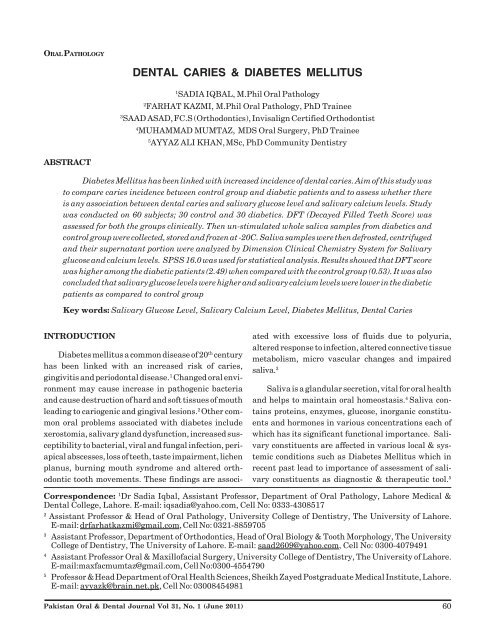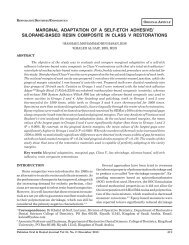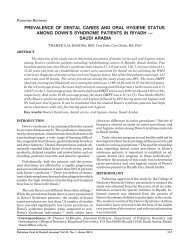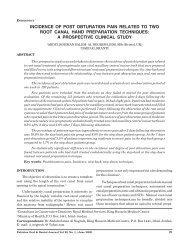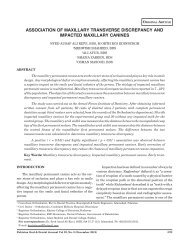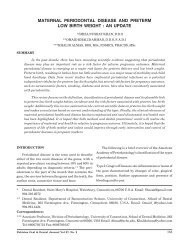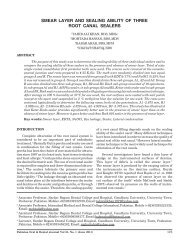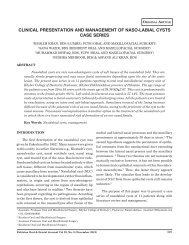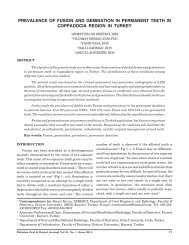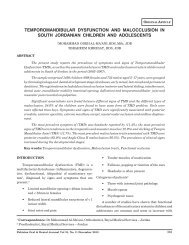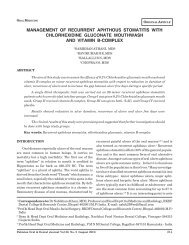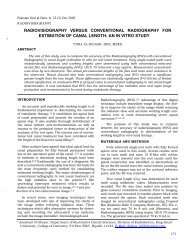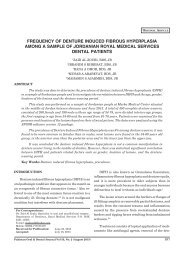Dental caries & diabetes mellitus - Pakistan Oral and Dental Journal ...
Dental caries & diabetes mellitus - Pakistan Oral and Dental Journal ...
Dental caries & diabetes mellitus - Pakistan Oral and Dental Journal ...
Create successful ePaper yourself
Turn your PDF publications into a flip-book with our unique Google optimized e-Paper software.
<strong>Dental</strong> Caries <strong>and</strong> Diabetes MellitusORAL PATHOLOGYDENTAL CARIES & DIABETES MELLITUS1SADIA IQBAL, M.Phil <strong>Oral</strong> Pathology2FARHAT KAZMI, M.Phil <strong>Oral</strong> Pathology, PhD Trainee3SAAD ASAD, FC.S (Orthodontics), Invisalign Certified Orthodontist4MUHAMMAD MUMTAZ, MDS <strong>Oral</strong> Surgery, PhD Trainee5AYYAZ ALI KHAN, MSc, PhD Community DentistryABSTRACTDiabetes Mellitus has been linked with increased incidence of dental <strong>caries</strong>. Aim of this study wasto compare <strong>caries</strong> incidence between control group <strong>and</strong> diabetic patients <strong>and</strong> to assess whether thereis any association between dental <strong>caries</strong> <strong>and</strong> salivary glucose level <strong>and</strong> salivary calcium levels. Studywas conducted on 60 subjects; 30 control <strong>and</strong> 30 diabetics. DFT (Decayed Filled Teeth Score) wasassessed for both the groups clinically. Then un-stimulated whole saliva samples from diabetics <strong>and</strong>control group were collected, stored <strong>and</strong> frozen at -20C. Saliva samples were then defrosted, centrifuged<strong>and</strong> their supernatant portion were analyzed by Dimension Clinical Chemistry System for Salivaryglucose <strong>and</strong> calcium levels. SPSS 16.0 was used for statistical analysis. Results showed that DFT scorewas higher among the diabetic patients (2.49) when compared with the control group (0.53). It was alsoconcluded that salivary glucose levels were higher <strong>and</strong> salivary calcium levels were lower in the diabeticpatients as compared to control groupKey words: Salivary Glucose Level, Salivary Calcium Level, Diabetes Mellitus, <strong>Dental</strong> CariesINTRODUCTIONDiabetes <strong>mellitus</strong> a common disease of 20 th centuryhas been linked with an increased risk of <strong>caries</strong>,gingivitis <strong>and</strong> periodontal disease. 1 Changed oral environmentmay cause increase in pathogenic bacteria<strong>and</strong> cause destruction of hard <strong>and</strong> soft tissues of mouthleading to cariogenic <strong>and</strong> gingival lesions. 2 Other commonoral problems associated with <strong>diabetes</strong> includexerostomia, salivary gl<strong>and</strong> dysfunction, increased susceptibilityto bacterial, viral <strong>and</strong> fungal infection, periapicalabscesses, loss of teeth, taste impairment, lichenplanus, burning mouth syndrome <strong>and</strong> altered orthodontictooth movements. These findings are associatedwith excessive loss of fluids due to polyuria,altered response to infection, altered connective tissuemetabolism, micro vascular changes <strong>and</strong> impairedsaliva. 3Saliva is a gl<strong>and</strong>ular secretion, vital for oral health<strong>and</strong> helps to maintain oral homeostasis. 4 Saliva containsproteins, enzymes, glucose, inorganic constituents<strong>and</strong> hormones in various concentrations each ofwhich has its significant functional importance. Salivaryconstituents are affected in various local & systemicconditions such as Diabetes Mellitus which inrecent past lead to importance of assessment of salivaryconstituents as diagnostic & therapeutic tool. 5Correspondence: 1 Dr Sadia Iqbal, Assistant Professor, Department of <strong>Oral</strong> Pathology, Lahore Medical &<strong>Dental</strong> College, Lahore. E-mail: iqsadia@yahoo.com, Cell No: 0333-43085172Assistant Professor & Head of <strong>Oral</strong> Pathology, University College of Dentistry, The University of Lahore.E-mail: drfarhatkazmi@gmail.com, Cell No: 0321-88597053Assistant Professor, Department of Orthodontics, Head of <strong>Oral</strong> Biology & Tooth Morphology, The UniversityCollege of Dentistry, The University of Lahore. E-mail: saad2609@yahoo.com, Cell No: 0300-40794914Assistant Professor <strong>Oral</strong> & Maxillofacial Surgery, University College of Dentistry, The University of Lahore.E-mail:maxfacmumtaz@gmail.com, Cell No:0300-45547905Professor & Head Department of <strong>Oral</strong> Health Sciences, Sheikh Zayed Postgraduate Medical Institute, Lahore.E-mail: ayyazk@brain.net.pk, Cell No: 03008454981<strong>Pakistan</strong> <strong>Oral</strong> & <strong>Dental</strong> <strong>Journal</strong> Vol 31, No. 1 (June 2011)60
<strong>Dental</strong> Caries <strong>and</strong> Diabetes Mellitusthough salivary constituents are changed in <strong>diabetes</strong>but what is its impact on <strong>caries</strong> is not clearly explained. 6<strong>Dental</strong> <strong>caries</strong> <strong>and</strong> salivary factors have attractedless interest, <strong>and</strong> the results are divergent as towhether <strong>caries</strong> risk is different or salivary factors areaffected in diabetic patients compared to controls.Equal <strong>caries</strong> rates in diabetic patients <strong>and</strong> controlshave been reported in many studies1. 7,8 A higher <strong>caries</strong>risk among diabetic patients than healthy controls hasalso been demonstrated 9,10 , but in contrast, some studieshave found even less <strong>caries</strong> in diabetic patients thanin controls. 9In <strong>Pakistan</strong> no studies on changes in salivaryconstituents in diabetic patients were available onsearch of literature. Thus there is need for an investigationfocused on the assessment of salivary glucose<strong>and</strong> calcium levels in diabetics. Thus the present studyhas been aimed at assessing the salivary glucose &calcium levels in diabetic patients <strong>and</strong> their linkagewith dental <strong>caries</strong>.METHODOLOGYThe study was conducted on 60 patients, out ofwhom 30 were diabetics (Fasting Blood Sugar Level>120mg/dl, HbA1c level > 7.0%), who were registeredin the endocrinology department of Shaikh ZayedMedical Complex, Lahore <strong>and</strong> 30 were normal nondiabetics(Fasting Blood Sugar Level between 70-120mg/dl, HbA1c level < 7.0%), who were under treatmentin dental / orthodontic department of Faculty ofDentistry, The University of Lahore. Un-cooperativepatients, patients with any active systemic disease <strong>and</strong>patients with missing teeth were excluded from thestudy.the hexokinase-glucose-6-phosphate dehydrogenasemethod. The calcium method used on the dimension®clinical chemistry system is an in vitro diagnostic test.The calcium method is the modification of the calciumo-cresolphthalein complexone (OCPC) reaction.Intra-oral examination was performed to assessthe DFT in normal & diabetic patients with the aimthat whether <strong>caries</strong> incidence was more in diabetics<strong>and</strong> whether there was any association of <strong>caries</strong> withsalivary glucose <strong>and</strong> calcium levels.SPSS 16.0 was used for statistical evaluation.Mean, St<strong>and</strong>ard Deviation, Variance, Minimum &Maximum value <strong>and</strong> Range were calculated for eachvariable for each subject. Salivary Glucose & Calciumlevel for normal & diabetics was assessed <strong>and</strong> corelationwith <strong>caries</strong> incidence was establishedRESULTSTABLE 1: COMPARISON OF SALIVARY GLUCOSELEVELS AMONG STUDY GROUPSStudy Groups Salivary Glucose (mg/dl)Mini- Maxi Mean ± SDmum mumControls (n=30) 3.0 9.0 7.33 1.36Diabetic Patients 10.50 19.50 15.60 2.48(n=30)Glucose concentration (mg/dl) in saliva in patients with<strong>diabetes</strong> <strong>mellitus</strong> was compared with healthy population.Glucose concentration in saliva of diabetic patientswas significantly higher as compared to healthypopulation (p = 0.001 < 0.05).Un-stimulated whole saliva from diabetic <strong>and</strong> controlgroup was collected in sterilized plastic jars throughspitting method <strong>and</strong> stored in freezer at -20degreecentigrade <strong>and</strong> then brought to the laboratory in a icechilled box. Saliva samples were defrosted, centrifuged<strong>and</strong> its supernatant portion was used for analysis whichwas carried out by using auto analyzer (DimensionClinical Chemistry System). Salivary glucose & Calciumlevels were analyzed by using Dimension ClinicalChemistry System. The glucose method used on theDimension® clinical chemistry system is an in vitrodiagnostic test. The Glucose method is an adaptation of<strong>Pakistan</strong> <strong>Oral</strong> & <strong>Dental</strong> <strong>Journal</strong> Vol 31, No. 1 (June 2011)Fig 1:Comparison of Salivary Glucose levels (minimum& maximum) among study groups61
<strong>Dental</strong> Caries <strong>and</strong> Diabetes MellitusTABLE 2: COMPARISON OF SALIVARY CALCIUMLEVELS AMONG STUDY GROUPSStudy Groups Salivary Calcium (mg/dl)Mini- Maxi Mean ± SDmum mumControls (n=30) 8.50 12.50 10.40 1.14Diabetic Patients 1.80 5.70 3.73 1.01(n=30)Calcium levels (mg/dl) in saliva of patients with <strong>diabetes</strong><strong>mellitus</strong> were compared with healthy controls <strong>and</strong> it wasshown that their level was significantly low in cases ascompared to the normal controls. (p = 0.001< 0.05).TABLE 4: CO-RELATION BETWEEN SALIVARYGLUCOSE LEVEL AND DFT AMONG DIABETICPATIENTSTeeth Decayed /FilledSalivary Glucose mg/dl 0.385 *Salivary glucose level was correlated with the destructionof permanent teeth among diabetics <strong>and</strong> it wasshown that mean glucose level increased with theincrease in number of decayed teeth.TABLE 5: CO-RELATION BETWEEN SALIVARYCALCIUM LEVEL AND DFT AMONG DIABETICPATIENTSTeeth Decayed /FilledSalivary Calcium mg/dl -0.287 *Mean salivary calcium level was calculated in alldiabetic subjects having permanent/ decayed teeth.Statistically significant co-relation was found betweensalivary calcium level <strong>and</strong> the number of permanentteeth decayed / filled.Fig 2:Comparison of Salivary Calcium levels (minimum& maximum) among study groupsTABLE 3: DECAYED FILLED PERMANENTDENTITIOND (decayed)F (filled) DFTControl 0.4 0.13 .53Diabetic Patients 2.31 0.14 2.49It can be observed that in diabetic patients DFT scorewas higher (2.49) as compared to control group (0.53).DISCUSSIONPresent study revealed that glucose levels in theun-stimulated whole saliva of IDDM group were higherthan in healthy subjects. The mean salivary glucoselevel in diabetic patients was 15.60 ± 2.48 <strong>and</strong> that ofcontrol was 7.33 ± 1.36mg/dl., so glucose concentrationin saliva of diabetic patients was significantly higher ascompared to healthy population (p = 0.001 < 0.05).These results are in agreement with reports of otherresearchers who found the same increased correlatedlevels of glucose in the saliva. 11,12 In one of the studymean <strong>and</strong> st<strong>and</strong>ard deviation of glucose level in diabeticchildren was found to be 2.05±1.63 where as innon-diabetic children was 1.03±1.03, indicating thatsalivary glucose level was higher in diabetics. 5 Kjellman 13<strong>and</strong> Thorstensson et al 14 reported significantly highervalues of glucose in whole saliva in diabetics than inhealthy controls. In contrast, other studies of diabetics<strong>and</strong> healthy individuals indicate that no such relationshipsexist. 15,16Fig 3:Comparison of decayed filled permanent dentitionin Control group & diabetic patientsCalcium levels in the present study were low indiabetics as compared to controls. Mean calcium levelin controls was 10.40 mg/dl <strong>and</strong> that of diabetics were3.73 mg/dl. (p = 0.001< 0.05). Previous study by Maria<strong>Pakistan</strong> <strong>Oral</strong> & <strong>Dental</strong> <strong>Journal</strong> Vol 31, No. 1 (June 2011)62
<strong>Dental</strong> Caries <strong>and</strong> Diabetes MellitusEL. supports the results of this study, also having lowcalcium value in diabetics that is mean of salivarycalcium in diabetic was 2.93mg/dl <strong>and</strong> in non-diabetic3.44mg/dl. In contrast to this, another study shows thatthere is no significant difference of calcium in salivabetween the two groups. 17-19The findings of the present study suggest thatbeside the clinical examinations, the determination ofthe possible alterations in the composition of wholesaliva might also be helpful in underst<strong>and</strong>ing theincreased severity of dental <strong>caries</strong> in diabetic patients.An increase in dental <strong>caries</strong> in permanent teethwas observed among diabetics. DFT in diabetic patientswas 2.49 where as in control group DFT was 0.53. Onemore study shows that diabetics have higher DMFTvalues as compared to the control group children 5 .REFERENCES1 National <strong>diabetes</strong> educational program. <strong>Oral</strong> health <strong>and</strong> Diabetes.Available from, www.ndep.nih.gov/<strong>diabetes</strong>.2 Aren G et al. Periodontal health, salivary status <strong>and</strong> metaboliccontrol in children with type1 <strong>diabetes</strong> <strong>mellitus</strong>. J Periodontal.2003; 74:1789-95.3 WHO/International <strong>diabetes</strong> federation. Launch of <strong>diabetes</strong>action now. 5th May 2004, Geneva, Switzerl<strong>and</strong>.4 Herenia P Lawrence. Salivary Markers of Systemic Disease:Non invasive Diagnosis <strong>and</strong> Monitoring of General Health. JCan Dent Assoc 2002; 68:170-74.5 Lopez M E et al. A. Salivary characteristics of diabetic children:Brazilian <strong>Dental</strong> <strong>Journal</strong>. June 2003:14:1.6 Vernillo A T. <strong>Dental</strong> consideration for the treatment ofpatients with <strong>diabetes</strong> <strong>mellitus</strong>. <strong>Journal</strong> of American <strong>Dental</strong>Association 2003; 134:24S-33S.7 Ben-Aryeh H, Cohen M, Kanter Y, Szargel R, Laufer D.Salivary composition in diabetic patients. J Diabet Complications1988;2: 96–99.8 Belazi MA, Galli-Tsinopoulou A, Drakoulakos D, Fleva A,Papanayiotou PH. Salivary alterations in insulin-dependent<strong>diabetes</strong> <strong>mellitus</strong>. Int J Paediatr Dent 1998; 8: 29–33.9 Twetman S et al. Two-year longitudinal observations ofsalivary status <strong>and</strong> dental <strong>caries</strong> in children withinsulin-dependent <strong>diabetes</strong> <strong>mellitus</strong>. Pediatr Dent 1992;14:184–88.10 Tenovuo J et al. <strong>Oral</strong> health of patients with insulindependent<strong>diabetes</strong> <strong>mellitus</strong>. Sc<strong>and</strong> J Dent Res 1986; 94:338–46.11 Darwazeh AMG et al. Mixed salivary glucose levels <strong>and</strong>c<strong>and</strong>idal carriage in patients with <strong>diabetes</strong> <strong>mellitus</strong>. J <strong>Oral</strong>Pathol Med 1991; 20: 280–83.12 Camp Bell MJA. Glucose in the saliva of the non diabetic <strong>and</strong>the diabetic patient .Archive of <strong>Oral</strong> Biology 1965; 10:197-205.13 Kjellman O. The presence of glucose in gingival exudates <strong>and</strong>resting saliva of subjects with insulin-treated <strong>diabetes</strong> <strong>mellitus</strong>.Swede Dent J 1970; 63: 11–19.14 Thorstensson H et al. Some salivary factors in insulin-dependentdiabetics. Acta Odontol Sc<strong>and</strong> 1989; 47: 175–83.15 Hara K et al. Carbohydrate components of the gingivalexudates. J Periodontal Res 1969; 4: 202–07.16 Karjalainen KM et al. Salivary factors in children <strong>and</strong> adolescentswith insulin dependent <strong>diabetes</strong> <strong>mellitus</strong>. Pied Dent1996; 18:306-11.17 Twetman S et al. Mutans streptococci <strong>and</strong> lactobacilli in salivafrom children with insulin-dependent <strong>diabetes</strong> <strong>mellitus</strong>. <strong>Oral</strong>Microbiol Immunol 1989; 4:165–68.18 Marchisio O, Esposito MR, Genovesi A. Salivary pH level <strong>and</strong>bacterial plaque evaluation in orthodontic patients treatedwith Recaldent products. Int J Dent Hyg. 2010 Aug;8(3):232-3619 Jawed M, Shahid SM, Qader SA, Azhar A. <strong>Dental</strong> Carries in<strong>diabetes</strong> <strong>mellitus</strong>: Role of Salivary flow rate & minerals. JDiabetes Complications 2010;25(3):183-86.<strong>Pakistan</strong> <strong>Oral</strong> & <strong>Dental</strong> <strong>Journal</strong> Vol 31, No. 1 (June 2011)63


